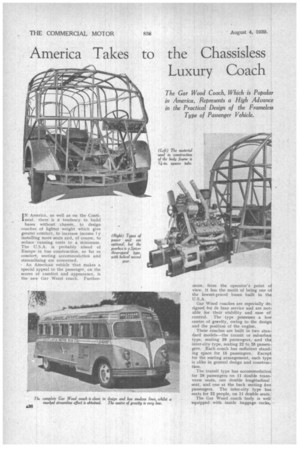America Takes to the Chassisless Luxury Coach
Page 38

Page 39

If you've noticed an error in this article please click here to report it so we can fix it.
The Gar Wood Coach, Which is Popular in America. Represents a High Advance in the Practical Design of the Frameless Type of Passenger Vehicle.
j1s1 America, as well as on tbe Conti! nent, there is st tendency to build buses without chassis, to design coaches of lighter weight which give greater comfort, to increase income ly installing more seats and, of course, to reduce running costs to a minimum. The U.S.A. is probably ahead of Europe in bus construction, so far as comfort, seating accommodation and streamlining are concerned.
• An American vehicle that makes a special appeal to the passenger, on the scores of comfort and appearance, is the new Gar Wood coach. Further more, from the operator's point of view, it has the merit of being one of the lowest-priced buses built in the U.S.A.
Gar Wood coaches are especially designed for de luxe service and are notable for their stability and ease of control. The type possesses a low centre of gravity, owing to the design and the position of the engine.
These coaches are built in two standard models—the transit or suburban type, seating 29 passengers, and the inter-city type, seating 22 to 25 passengers. Each coach has sufficient standing space for 15 passengers. Except for the seating arrangement, each type is alike in general design and construction.
The transit type has accommodation for 29 passengers on 11 double transverse seats, one double longitudinal seat, and one at the back seating five passengers. The inter-city type has seats for 22 people, on 11 double seats.
The Gar Wood coach body is well equipped with inside baggage racks, built into each side, above the windows. The luggage space of the intercity type is not: large, but the design permits luggage to be placed under the seats. There is also plenty of space in the driver's compartment for parcels.
The side panels are j-in. thick and made of tempered Masonite. The ceiling panels are of sheet aluminium. Extruded, polished-aluminium mouldings for the sides give the vehicle a most pleasing appearance. All windows arc of safety glass. Those at the sides arc of the two-piece sliding pattern and have polished aluminium frames.
The entrance door is of the positivelocking, two-piece inward-sliding type and is vacuum operated. The coach is also provided with an emergency door, located at the rear near side.. A " " light on the instrument panel flashes when it is open.
An important feature of the coach is the fact that it incorporates an acety li4ne-welded 1 t-in, square tubular framework. High carbon, -chromiummanganese steel tubing is used in all the principal members and in the trussing and bracing. There are no bolts, rivets, screws or wood.
The ongine and clutch may be selected by the operator, although it is customary to use Ford V8, Chevrolet or Dodge lorry units. A Spicer gearbox is provided, this being of the threespeed bus type.
The propeller shaft is a Spicer component and has two universal Joints with needle bearings. The rear axle is of the Timken fully floating type.
Lockheed four-wheel hydraulic brakes are employed, the total brakelacing area being 321 sq. ins. The brake mechanism is assisted by a Bendix 6-in. diameter booster. Alternatively, Bendix Westinghouse air brakes may be fitted.
The steering gear is of the Ross cam
and-lever type and is roller mounted, the ratio being 20 to 1.
Budd disc wheels with 6-in, rims are provided. Heavy low-pressure 7.00 by 20 tyres (single front and dual rear) . are standard equipment. The fuel tank has a capacity of 50 gallons, is located on the right-hand side beneath the floor, and is fully protected by the frame structure.
Gar Wood rear-engined coaches have been in service on American streets and highways for several years past. These coaches have travelled close on 5,000,000 miles in the U.S.A. Because they are from 2,000 lb. to 5,000 'lb. lighter in weight than normal buses— yet possess unusual strength—they have, according to bus operators, established new records of economical per-, formance. Gar Wood coaches are now in daily use throughout the north-east of the United States, in the West and in Canada. R.L.B.




































































